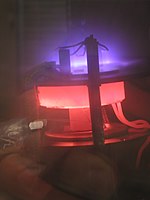
Photo from wikipedia
Microwave (MW) dielectric ceramics are used in numerous electronic components for modern wireless communication systems, including antennas, resonators, capacitors and filters. However, to date, MW ceramics are manufactured by an… Click to show full abstract
Microwave (MW) dielectric ceramics are used in numerous electronic components for modern wireless communication systems, including antennas, resonators, capacitors and filters. However, to date, MW ceramics are manufactured by an energy-intensive, conventional high-temperature (> 1000 °C) sintering technology and thus cannot be co-sintered with low melting point and base electrodes (Ag, Al, etc., < 1000 °C), nor directly integrated with polymers (< 200 °C). Cold sintering is able to densify ceramics at < 200 °C via a combination of external pressure and a transient liquid phase, reducing the energy consumed and facilitating greater integration with dissimilar materials. This review outlines the basics of MW ceramics alongside the mechanism of cold sintering. Recent developments in cold sintering of MW ceramics, composites and devices are described, emphasizing new materials and progress towards component/device fabrication. Future prospects and critical issues for advancing cold-sintered MW materials and devices, such as unclear mechanism, low Q × f values and poor mechanical properties, are discussed.
Journal Title: Journal of Materials Research
Year Published: 2021
Link to full text (if available)
Share on Social Media: Sign Up to like & get
recommendations!